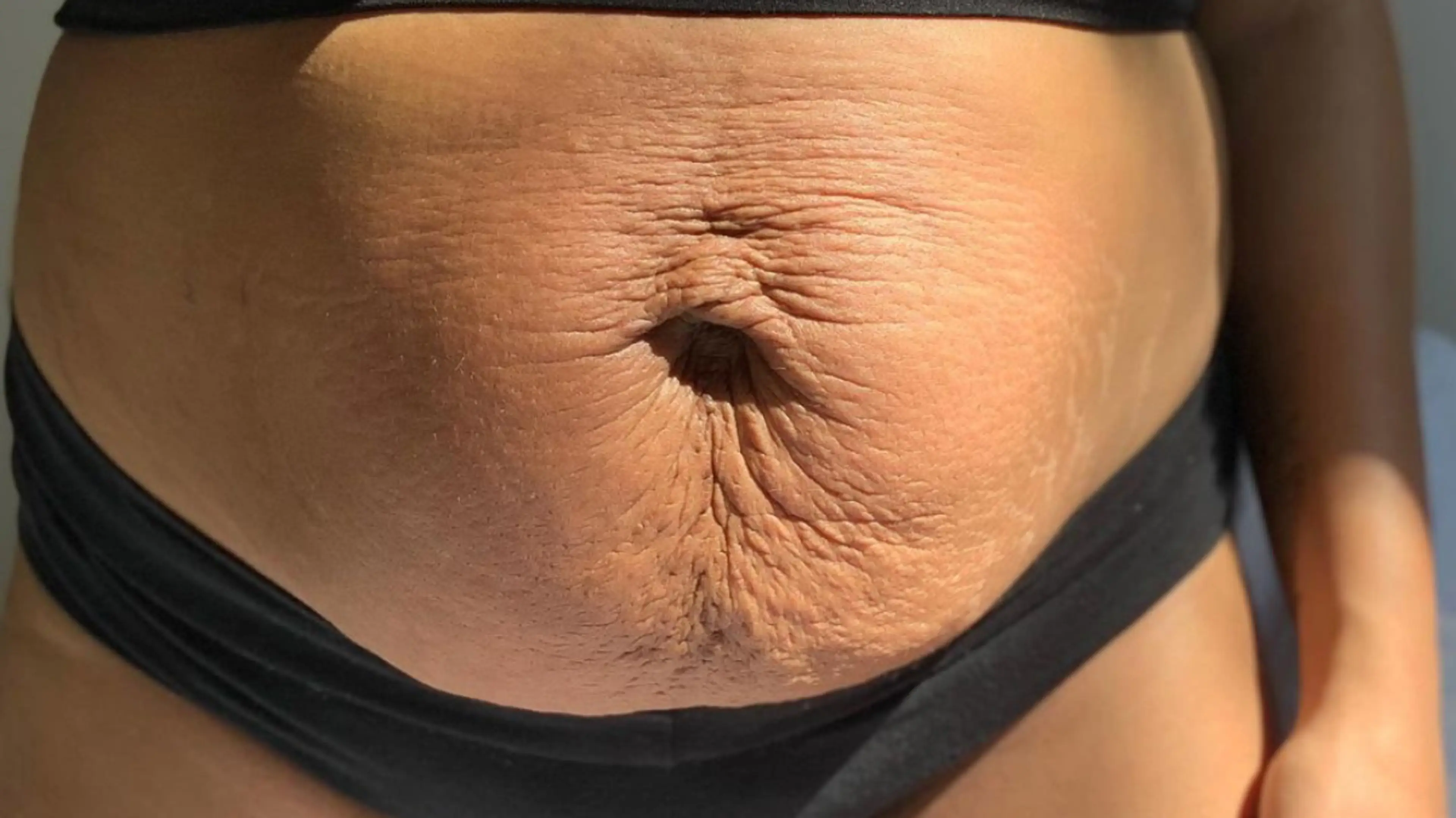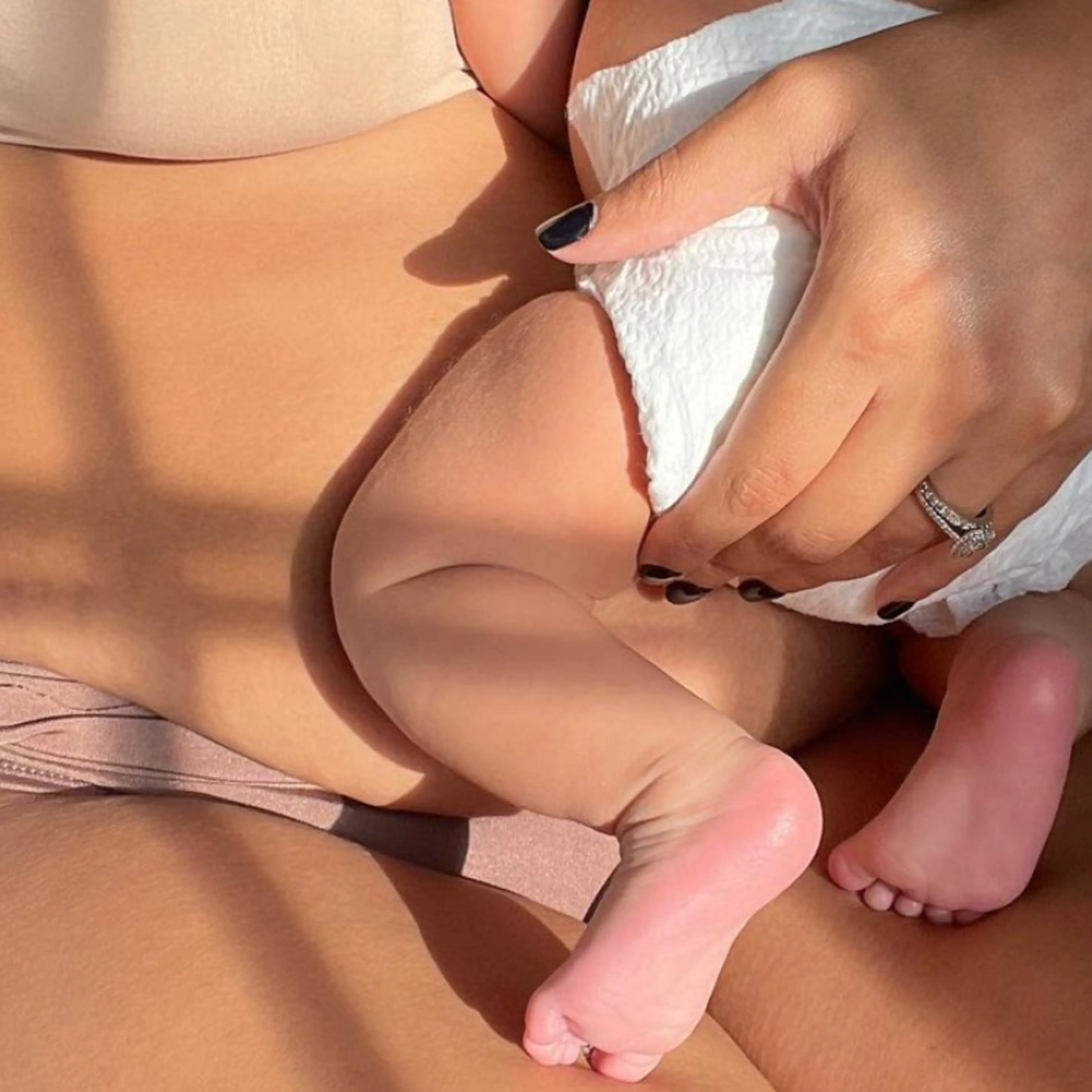It’s a given that your body will change during pregnancy: your belly will stretch, you’ll probably get a dark line under your belly button (otherwise known as linea nigra), and if you’re one of the lucky ones, maybe you’ll notice glowing skin and shiny hair.
But once your baby arrives earthside, the story is too often the same: your health as a new mom takes a backseat to caring for your newborn. It doesn’t help that the six-week postpartum check-up is kind of a joke. In addition to filling out a survey that asks absurd questions like, “Have you cried in the last week?” (yes, you have, because a small human just exited your body and you have a new eye twitch) typically the OB will check that your stitches have healed and bleeding has stopped or mostly stopped, then they’ll clear you for exercise and sex. Six weeks after giving birth and you’re suddenly back to normal life? Hardly.
So, it makes sense that many postpartum women find themselves shocked and unprepared by the physical changes they experience. Plus, we live in a culture that is obsessed with unrealistic and sometimes disturbing expectations of “bouncing back,” and we rarely talk about the ways in which bodies change postpartum—sometimes permanently.
But no longer. We’re here to bust through this veil of secrecy and get into it: the good, the bad, and the strange when it comes to living in a postpartum body.
Your Pelvic Floor
The placenta is an amazing organ. (Fun fact: it actually shares DNA with the baby, not the mother.) One of the many jobs of the placenta is to secrete a hormone called relaxin which makes the ligaments in the pelvis (and other parts of the body) more flexible and softens the cervix.
“Your pelvic floor muscles have to work overtime during pregnancy and then have to stretch to up to 250% their resting length to give birth,” says pelvic floor physical therapist Dr. Jen Buono1 . When your pelvis becomes more stretchy and lax, it also becomes less stable. Think of your pelvic floor like a trampoline, it moves and adapts, but you wouldn’t want to rest a drink on it.
“Your pelvic floor tries to step in to make up for some of that extra flexibility. If your pelvic floor isn’t strong enough to handle all that extra work, the muscles will tighten to give you the stability that your strength can’t.”
She adds that during labor and delivery, those same muscles need to relax and lengthen to allow your baby to enter the world. “When we try to stretch things that have become extra tight, that’s where we can get some of that tearing.”
What can you do about it?
Your pelvic floor is something that you’ll definitely want to rehab postpartum (with the help of a pelvic floor therapist). When you’re tired, feeding your baby around the clock, and just generally in a haze, it’s easy to stop checking in with your body. But unaddressed pelvic floor issues can cause a whole slew of issues, including fecal or urinary incontinence, constipation, pelvic or hip pain, and painful sex. While it’s often joked about, giving birth really does not mean that you’ll pee when you sneeze for the rest of your life.
In order to set yourself up for an easier recovery, it’s important to lay the foundation early. Before you give birth, work on strengthening, lengthening, and relaxing the pelvic floor. “Start right away with reconnecting to your breath, your diaphragm, and your pelvic floor,” Dr. Buono says. As you get closer to your due date (around 35 weeks), perineal stretches can also help to prevent tearing. “Slowly add in light pelvic floor contractions. As you get back into exercise, be sure to rebuild your hip muscles and do compound movements like squats and deadlifts to help functionally strengthen your pelvic floor.”
Your Feet
Maybe Carrie Bradshaw didn’t have kids because she didn’t want to ditch her shoe collection. Yep, during pregnancy, you may notice that your feet get bigger, and we don’t mean that they swell to epic proportions (although they do that too). In fact, studies show2 that some people’s feet increase in length, width, and volume during pregnancy, and sometimes this change is permanent (sorry). Feet tend to get flatter too, which is part of the reason for the increased length.
“During pregnancy, your hormones cause all the ligaments and joints in your body to become more flexible, and that includes all the ones in your feet,” Dr. Buono says.
Even after your hormones regulate, the months of walking on your feet and reinforcing the new shape take a toll. “Postpartum, your plantar fascia is stretched out, and your foot muscles are stretched out and weakened,” she says. This can cause pain while doing something as simple as walking—not good news when you’re relying on sanity walks around the neighborhood in the early postpartum days.
What can you do about it?
Well, first, the meh news. You can’t do anything about the after-effects of ligament laxity thanks to the hormone relaxin, our buddy who allows the pelvis to stretch but doesn’t get the memo that your feet don’t also need to grow. If you’re experiencing foot pain during or after pregnancy, you can wear an insole or an orthotic designed to correct the flatness of the foot. The good news is, it doesn’t have to be an upscale version. “Research shows that the ones you can get at a drug store are as effective as the fancy ones from the podiatrist. So just find a pair that feels comfortable to you,” Dr. Buono says.
And while you may not be able to shrink your feet (our apologies to your favorite pair of college Birkenstocks), working on foot-strengthening exercises before and after you deliver can help. Both Dr. Buono and Dr. Kandis B Daroski, a physical therapist with Hinge Health3 , recommend adding toe raises, towel scrunches, or heel raises with a towel under your big toe to your routine.
“After you give birth, the length of your foot may return to normal, but you may continue to have flat arches,” Dr. Daroski says, adding that it’s important to do exercises targeted not only at strengthening the arch of the foot but also focusing on other parts of the body, like the hips, knees, and shoulders, which affect foot positioning.
Your Abs
Imagine a flower bursting out of a seed—the seed has no choice but to open to make room for the new growth. Well, the seed is like your abs, which have to separate to make room for your growing belly. This separation is known as diastasis recti, and Dr. Buono says it happens to some degree in 100% of pregnancies. “Those six-pack muscles in the front are connected by a line of connective tissue. That tissue stretches and expands to allow for the separation,” she says.
What can you do about it?
The good news? While it sounds like it would be painful, diastatis recti really isn’t and upwards of 70 percent of cases heal on their own with no special interventions.
“We can give our body the best chance of healing by avoiding exercises and movements that cause repetitive ‘coning’ or ‘doming’ of the abdomen,” Buono says, adding that coning or doming once in a while is fine. “But if there’s a movement that’s causing it to happen every time, we want to change up what we’re doing. One of my favorite easy fixes is to exhale with the movement. This prevents extra air pressure from building up and pressing out onto your diastasis.”
She also recommends starting with isometric exercises like planks, Pallof presses using a resistance band, or farmer’s carry, before moving on to core exercises with more movement or twists like pilates.
Your Teeth and Gums
You may have heard that your baby leaches calcium from your teeth (creepy). I’m happy to report that that’s not true, but pregnancy can do a number on your gums.
“Your pregnancy hormones estrogen and progesterone can make your gums more susceptible to the effects of plaque and change your tooth composition,” Buono says. “This can lead to irritation and inflammation of the gums and increased tooth sensitivity.” While rare, it’s also possible to experience a minor change in bite or jaw shape due to changes in ligament laxity, which can also exacerbate TMJ, causing pain in the jaw joint.
What can you do about it?
During pregnancy, make sure to maintain your dental hygiene. Try to avoid acidic foods that erode enamel. If your morning sickness is causing you to vomit, be sure to thoroughly rinse your mouth with water to clear out stomach acid.
Fortunately, if you maintain good hygiene (brush, floss, and maybe even water pik) and keep seeing your dentist regularly, changes to the gums usually resolve themselves postpartum.
Your Vagina
This one’s not a shocker, but it’s definitely worth mentioning. “After a vaginal delivery, the women's pelvic floor and vagina must go through a healing phase,” says Dr. Jennifer Anger4 , co-author of A Woman's Guide to Her Pelvic Floor: What the F*@# is Going On Down There5 . “Some women may notice urinary leaking with coughing, laughing, or sneezing (‘stress urinary incontinence’) that usually improves in the first few months. Any vaginal tears and/or incisions need time to heal.”
Women who give birth via C-section may also experience vaginal changes, especially those who pushed first. Everyone who gives birth will also continue to bleed for around six weeks–this is known as lochia, and it has a bit of a musty or metallic smell. Breastfeeding can also cause vaginal dryness and sometimes itching, thanks to a drop in estrogen.
What can you do about it?
“Many women practice Kegel exercises (squeezing the vaginal muscles) before they deliver to help strengthen the pelvic floor,” Dr. Anger says. Keep in mind that Kegels are only recommended for a loose pelvic floor, and doing them when your pelvic floor is actually too tight can make things worse.
Dr. Anger also says, “Taking vaginal estrogen cream while breastfeeding can prevent vaginal dryness and help the vaginal walls heal.” My pelvic floor therapist prescribed estrogen to me while breastfeeding, and while it wasn’t covered by my insurance, it made a big difference.
While you may feel like you could exercise (or you don’t have much choice in the matter because you’re constantly running after an older toddler) it’s important not to overexert yourself in the weeks after giving birth as it could make tearing worse and prolong postpartum healing. Short walks or gentle stretching is okay, but it’s really best not to exercise until you’re cleared.
Your Spine
Everyone is familiar with the pregnancy waddle—as your center of gravity moves forward, your belly grows, your lower back extends, and your upper back then has to round a bit, bringing your head forward. This can make your back feel sore, throw you off balance, and change your gait (hence the waddle), as well as the shape of your spine.
What can you do about it?
One thing you can do for this while pregnant is to be mindful of your posture. “When you’re standing, if you find yourself leaning your belly forward and clenching your butt underneath you, try to relax your glutes a bit, bring your belly closer underneath you, and lengthen as if someone was pulling from a string at the top of your head,” Dr. Buono says.
After giving birth, the spine will mostly straighten itself back up since your belly isn’t as big. but it may not totally go back to normal on its own. It helps to lengthen your lower back muscles, extend the upper back, and make sure your chin isn’t jutting out. “I typically have my moms do low back breathing, thoracic extensions on a foam roller, and chin tucks,” Dr. Buono says.
Your Glutes
As with your spine, a growing belly causes pregnant people to stand or sit differently, which can cause tightness or weakness in certain muscle groups.
“Pregnant women often develop a characteristic stance, arching their lower back more in response to their outward growing belly. Over time this can over-lengthen or stretch out your glutes, making them weaker and less shapely,” Dr. Daroski says.
Then post-pregnancy, you’re carrying your baby (and when you’re not, you’re carrying a laundry basket instead), which may cause you to tuck in your tailbone. “Spending a long time in this position can also weaken the glute muscles.” All this leads to a flatter butt.
What can you do about it?
Well, for starters, check yourself out. “One of the best strategies to prevent this is to become more aware of your posture. When looking in the mirror from the side, there should be a relatively straight line from your ear, shoulder, hip, and ankle,” Dr. Daroski says, adding that another helpful thing is to stay as active as possible during pregnancy, choosing exercises that focus on strengthening the deep, supportive abdominal muscles as well as the postural muscles of the upper back.
Unfortunately, you might not magically go back to your old posture once the baby is born. “Spending time performing intentional exercises is game-changing for reversing the effects and strengthening the glutes. Focus on strengthening all aspects of the hip and glute to ensure a good balance of strength to support you during daily movements,” Dr. Daroski says. She recommends bridges (double and single-legged), hip thrusts, and glute kickbacks on hands and knees (also known as donkey kicks).
Your Bra Band Size
First, it was your shoes, and now I’m telling you that you may have to say goodbye to your bras, too. While not everyone notices foot or bra band changes during pregnancy, some do. When it comes to your bra size, your band size may be bigger even after you’ve lost the pregnancy weight.
“During pregnancy, the ribs, especially the lowest few, have to expand or flare outward,” Dr. Daroski says. In my own pregnancy, the worst thing I experienced was actually nagging rib pain in the third trimester, something I wasn’t prepared for. “The ribs are connected to and surrounded by muscles which can become overly tight or lengthened in response to this change. This means that the ribs can stay flared out or expanded far past the time the baby is delivered.” This rib position can also be the culprit of postpartum rib and upper back pain.
What can you do about it?
“This change is unfortunately unavoidable,” Dr. Daroski says. But we wouldn’t leave you hanging. She adds that practicing deep breathing and abdominal muscle strengthening during pregnancy can limit the amount of flare that occurs and set you up for success in rehabbing postpartum.
“A great way to begin to address this problem is by working on 360 breathing. This type of deep breathing focuses on expanding and naturally drawing in the ribs and torso in a 360-degree direction to restore normal rib positioning,” she says.
Your ribs are also connected to your ab muscles, and by strengthening those muscles postpartum, you can decrease the rib flare and potentially return to your previous bra band size.
Your Brain
“Pregnancy brain” is actually a real thing caused by hormone shifts, which helps to explain why I constantly confused my microwave and freezer in the third trimester. “It’s not in your head,” Dr. Buoro says. “Well, actually, it is, but you know what I mean.”
During pregnancy, your brain physically changes shape and size. Your hippocampus, the part of your brain responsible for spatial awareness and both long-term memory and memory retrieval, actually shrinks. Sounds scary, right? Well, fortunately, this happens for a pretty cool reason.
“Your gray matter volume decreases, which is why you might have temporary memory and cognitive function effects. It can also change how you interpret and respond to emotions and social cues,” Dr. Buoro says. “This shift is actually getting you ready to accommodate the emotional and social demands of motherhood. It’s getting you ready to be more attuned to the emotional and social needs of your infant and making the brain areas related to empathy and intuition stronger.”
One study6 used an MRI to look at the brains of postpartum women. They found that the spots in the brain that had lost gray matter during pregnancy actually responded with the “strongest neural activity” when the women were shown pictures of their own babies. (This wasn’t the case when they looked at pictures of other babies.)
Two years later, 11 of the mothers (none of whom had gotten pregnant again) returned, and all the gray matter loss remained, except for the hippocampus, whose size was basically back to pre-pregnancy levels.
What can you do about it?
Try not to sweat it. You may have more trouble focusing on a movie or remembering some common word (I forgot the word “bench” when I had an infant), but know that it’s not permanent. “Estrogen and progesterone might be shrinking parts of your brain, but they’re also enhancing your brain’s neural plasticity, or its ability to reorganize and form new connections,” Dr. Buoro says. “This is how you’re able to adapt and learn new experiences.”
Be Kind to Yourself
Society doesn’t talk about postpartum changes once you have your baby. There are no more apps tracking what your body is doing, no monthly check-ins with the doctor. But you can’t just grow a full human and expect there to be no lasting effects. With patience, exercise, and ideally, the help of a physical or pelvic floor therapist, your body can and will settle into its new norm. You may even find that you’re stronger than ever thanks to your baby, who doubles as the cutest kettleball you’ve ever seen.












